The marine Diesel engine
Part one: The two stroke
Authored by: Martin Leduc, 2001
Brought to you by www.dieselduck.net, comments to [email protected]
 Heat engines are sometimes referred to as
being motors. Actually, a motor converts one form of energy into useful work
without the intentional production of heat, such as an electric motor. A
device which burns fuel creating heat to perform work is a heat engine. Heat
engines can be classified as external combustion, such as steam boiler, or
internal combustion (IC). They can further be divided into the spark ignited
(SI) engine or the compression ignited engine (CI). The particular heat
engine we are interested about with this webpage, is the Compression Ignited
heat engine. This style of engine has been most famously referred to as the
Diesel engine, named after it�s inventor,
Rudolph
Diesel.
Heat engines are sometimes referred to as
being motors. Actually, a motor converts one form of energy into useful work
without the intentional production of heat, such as an electric motor. A
device which burns fuel creating heat to perform work is a heat engine. Heat
engines can be classified as external combustion, such as steam boiler, or
internal combustion (IC). They can further be divided into the spark ignited
(SI) engine or the compression ignited engine (CI). The particular heat
engine we are interested about with this webpage, is the Compression Ignited
heat engine. This style of engine has been most famously referred to as the
Diesel engine, named after it�s inventor,
Rudolph
Diesel.
The compression ignited internal combustion engine has two main designs: the four stroke cycle, and the two stroke cycle engine. They are both very common throughout the world because of their high efficiency - compare with other types of heat engines. They burn a wide variety of hydrocarbon fuel, which is still common. Heavy fuel oil, intermediate fuel oil and marine diesel oil are the most common hydrocarbon fuel. The two stroke and four stroke titles refers to the mechanical action of the machinery, in particular the piston within the cylinder, to achieve the theoretical Carnot heat cycle, as define by the laws of thermodynamics.
Diesel engines are furthermore sub-divided into three categories: slow, medium and high speed. Slow speed are considered to be up to 300 rpm such as most big two stroke engines commonly found on ships. Medium speed engines dwell in the 300 - 900 rpm range. They are most common on smaller ships and power plants driving electrical generators and / or the propeller. High speed engines are the most common. Their high revolutions are ideal for driving vehicles such as busses and yachts. All Diesel trucks and vehicles on our roads use this class of Diesels, having an rpm over 900.
The two stroke engine...
It takes two strokes to complete a power
cycle: one stroke down, one stroke up, resulting in one turn of the
crankshaft. As oppose to the four stroke which must see the piston perform
four strokes and two crank rotations, in order to achieve one cycle. The
power stroke occurs at every down stroke which would lead us to believe the
two stroke to be twice as efficient. On large plants, the two stroke is
about 1.8:1 more powerful than a four stroke engine of similar weight. On
smaller application, i.e. a bus, the power/pound gap closes, and the effective horsepower of similar sized engines will be about
the same for the two and four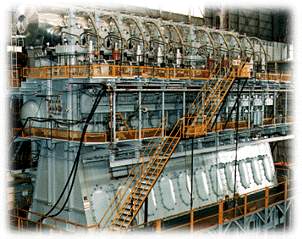 stroke.
stroke.
The two stroke is most commonly seen in application demanding a large power output, such as ships and electric generation plants. In the world of ships, these engines are large, especially tall; this is to accommodate the long stroke engine designers have come up with to increase the efficiency of the power stroke. Additionally, the large physical size of these power plants tends to slow them down.
This slow speed, around 100 rpm, has two benefits to an owner of a ships. The first, probably the most important, allows the engine to burn heavy fuel oil (HFO) efficiently. Although, the black, tar like substance can be used as fuel in both the four stroke and two stroke engine. This fuel is much cheaper, currently around $300USD/ton, compared to the "ordinary" refined diesel fuel oil (MDO), with the cost being around $600USD/ton.
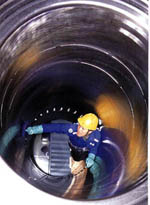 Slow speed, also allows a
direct coupling of the propeller shaft to the crankshaft, eliminating the
need for gearing and such. The reduction of associated gear serves to
increase their power to weight ratio which usually equates to lower cost. Additionally, the two stroke engines have a less complicated design, namely
no intake valves, this reduce the possibility of things failing. These
attributes give the two stroke engine advantages over the four strokes,
making it engine of choice for
Slow speed, also allows a
direct coupling of the propeller shaft to the crankshaft, eliminating the
need for gearing and such. The reduction of associated gear serves to
increase their power to weight ratio which usually equates to lower cost. Additionally, the two stroke engines have a less complicated design, namely
no intake valves, this reduce the possibility of things failing. These
attributes give the two stroke engine advantages over the four strokes,
making it engine of choice for almost all
large deep sea ships.
The most prominent builders of large, slow speed, two stroke engine are Sulzer of Switzerland, producer of the first big two stroke design, and Burmeister & Wain (B&W) of Denmark, the pioneers of the engine�s application to ship design. Other manufacturer also produce these types of engine, such as Kawasaki (Japan), Hyundai (Korea) and Fincantieri Naval (Italy) to name a few. Most shipbuilder build the Sulzer or B&W engines under license.
To the land-lubber, the biggest builder of two stroke engine is the Detroit Diesel Corporation. "Gee Mees", as they are commonly known, can be found extensively in transit busses, fire trucks and many military applications. EMD, another division of General Motors, also builds two stroke engine which are very common on the North American coast and in locomotives. Two stroke engine have a wide variety of power output from the 353 Detroit Diesel with an output of less than 75 kW to a Sulzer RT-flex96C producing a 80,080 kW or about 109,000 bhp from fourteen cylinders turning at 102 rpm.
Not to be outdone MAN B&W has come out with the K108ME-C. This things is un-precedent big ! Like the Sulzer, its a 14 cylinder, but the bore, the area of the top of the piston, is 108cm, that's over a meter wide. It can produce a mind numbing 97,300 kW, over 130,000 hp, turning a propeller of almost 30 feet wide at 94 rpm. Both these engines are develop to power the latest and largest container ships, expected to carry 10,000 to 12,000 teu, or about 6000 tractor trailer trucks.
The components...
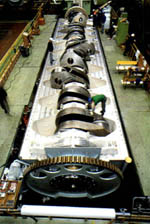 The heart of the two stroke engine comprises
of a cylinder liner with inlet ports about 2/3 of the distance from the top
of the liner. The cylinder head, also know as cylinder cover, contain the
exhaust valve's) (pictured above). The piston within the cylinder is connected to
the crankshaft by the
connecting rod. On the larger
engines, the power is transmitted to a cross head assembly first. The cross
head slide up and down with the piston and transmit power from it to the
connecting rod and crankshaft.
The heart of the two stroke engine comprises
of a cylinder liner with inlet ports about 2/3 of the distance from the top
of the liner. The cylinder head, also know as cylinder cover, contain the
exhaust valve's) (pictured above). The piston within the cylinder is connected to
the crankshaft by the
connecting rod. On the larger
engines, the power is transmitted to a cross head assembly first. The cross
head slide up and down with the piston and transmit power from it to the
connecting rod and crankshaft.
The two stroke engine is not a naturally aspirated engine. It depends on a positive charge of air to fill and scavenge the cylinder. This is provided by a blower which charges the air box. The blower can be mechanically driven, such as on the Gee Mees or electric motor driven on the bigger engines. Most engines nowadays are supercharged (turbocharger) as well.
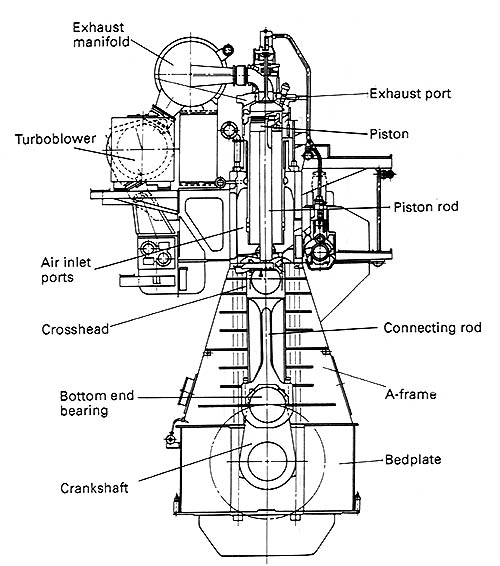
The chain reaction...
Describing the action of the piston within the cylinder generally start with the piston in the bottom dead center position (BDC), at the end of its travel downward before it�s travel upwards. With the piston, having covered the intake ports, travels upwards, compressing the trapped air from its original volume to a fraction of it, generally anywhere from 17:1 to 23:1 (gas engines are about 9:1) to about 42 bars (~600psi). The air�s volume reduction crushes the air molecule together and as a result, they build up heat.
Slightly before top dead center (TDC), around 10 degrees, injection of atomized fuel begins, it burns, ignited by the high temperature from to the air being compressed. Injection last about 30 degrees, this varies depending on load. The fuel continues to burn and expands which increases the pressure and temperature within the cylinder. Around 15 degrees after TDC, combustion is complete and maximum pressure is reached within the cylinder, this stage is commonly called Pmax. Pmax is anywhere between 180 bars to 195 bars (~2500 - 2800 psi); this is why Diesel engine construction is so robust, it is to withstand this pressure.
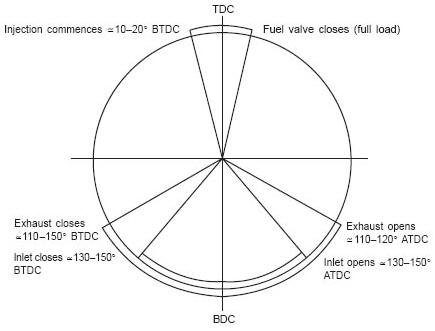 |
|
| The above
timing diagram is a general one, of a two stroke engine design having inlet and exhaust ports in the cylinder liner or inlet port in the liner and valve exhaust in a cylinder cover. |
|
|
|
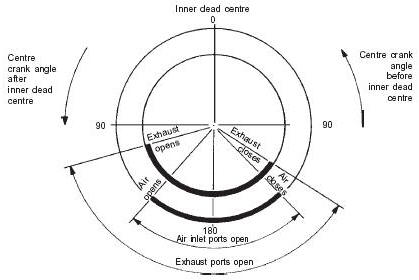 |
| The above timing
diagram, of unknown origins, is most likely for a two stroke engine
which has inlet and exhaust ports milled into the cylinder liner, with
cylinder cover (head) being just a cover.
1-2 injection
(fuel), 2-3
expansion (power), 3-5 exhaust |
The above timing diagram is for an opposed piston engine, the Doxford 76J4C. From Pounder's |
The pressure force acts upon the area of the piston crown, pushing it down. This downward force is transmitted to the crankshaft by the connecting rod, transforming it into a rotational force. About 45 degrees before BDC and just prior to uncovering the inlet ports near the bottom of the cylinder, the exhaust valve open, releasing the pressure in the cylinder. The exhaust gases at this stage are about 600 degrees.
The continued downward travel of the piston
uncovers the inlet ports, where positively charged air, 30-70 kPa (3-4 psi),
provides a scavenging effect to drive exhaust gases out through the exhaust valve.
This action not only clears the cylinder of spent gases but also cools the
cylinder. Around 35 degrees after BDC the exhaust valve closes, and at 50 degrees
after BDC the inlet ports are covered (closed).
With the inlet ports being covered by the upward traveling piston, the compression stroke begins again with a fresh charge of air. Thus the two stroke earns it�s name, one downwards (power stroke) and the upward stroke (compression stroke) complete one cycle.
The above process is best illustrated by the following diagram, courtesy of Rick Bogg's Merchant Marine website.
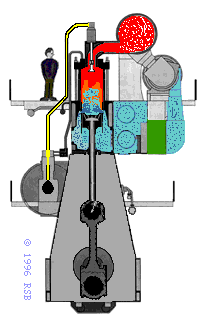
M.A.N put out this video, which illustrates this whole web page. Check it out here.
Next part: the four stroke
Visit Rollo Tomkins' excellent site which dissects all the engine's parts